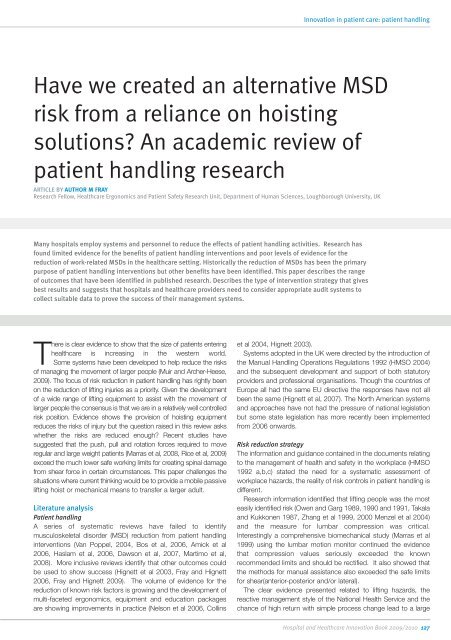Full document - International Hospital Federation
Full document - International Hospital Federation
Full document - International Hospital Federation
Create successful ePaper yourself
Turn your PDF publications into a flip-book with our unique Google optimized e-Paper software.
Innovation in patient care: patient handling<br />
Have we created an alternative MSD<br />
risk from a reliance on hoisting<br />
solutions? An academic review of<br />
patient handling research<br />
ARTICLE BY AUTHOR M FRAY<br />
Research Fellow, Healthcare Ergonomics and Patient Safety Research Unit, Department of Human Sciences, Loughborough University, UK<br />
Many hospitals employ systems and personnel to reduce the effects of patient handling activities. Research has<br />
found limited evidence for the benefits of patient handling interventions and poor levels of evidence for the<br />
reduction of work-related MSDs in the healthcare setting. Historically the reduction of MSDs has been the primary<br />
purpose of patient handling interventions but other benefits have been identified. This paper describes the range<br />
of outcomes that have been identified in published research. Describes the type of intervention strategy that gives<br />
best results and suggests that hospitals and healthcare providers need to consider appropriate audit systems to<br />
collect suitable data to prove the success of their management systems.<br />
There is clear evidence to show that the size of patients entering<br />
healthcare is increasing in the western world.<br />
Some systems have been developed to help reduce the risks<br />
of managing the movement of larger people (Muir and Archer-Heese,<br />
2009). The focus of risk reduction in patient handling has rightly been<br />
on the reduction of lifting injuries as a priority. Given the development<br />
of a wide range of lifting equipment to assist with the movement of<br />
larger people the consensus is that we are in a relatively well controlled<br />
risk position. Evidence shows the provision of hoisting equipment<br />
reduces the risks of injury but the question raised in this review asks<br />
whether the risks are reduced enough? Recent studies have<br />
suggested that the push, pull and rotation forces required to move<br />
regular and large weight patients (Marras et al, 2008, Rice et al, 2009)<br />
exceed the much lower safe working limits for creating spinal damage<br />
from shear force in certain circumstances. This paper challenges the<br />
situations where current thinking would be to provide a mobile passive<br />
lifting hoist or mechanical means to transfer a larger adult.<br />
Literature analysis<br />
Patient handling<br />
A series of systematic reviews have failed to identify<br />
musculoskeletal disorder (MSD) reduction from patient handling<br />
interventions (Van Poppel, 2004, Bos et al, 2006, Amick et al<br />
2006, Haslam et al, 2006, Dawson et al, 2007, Martimo et al,<br />
2008). More inclusive reviews identify that other outcomes could<br />
be used to show success (Hignett et al 2003, Fray and Hignett<br />
2006, Fray and Hignett 2009). The volume of evidence for the<br />
reduction of known risk factors is growing and the development of<br />
multi-faceted ergonomics, equipment and education packages<br />
are showing improvements in practice (Nelson et al 2006, Collins<br />
et al 2004, Hignett 2003).<br />
Systems adopted in the UK were directed by the introduction of<br />
the Manual Handling Operations Regulations 1992 (HMSO 2004)<br />
and the subsequent development and support of both statutory<br />
providers and professional organisations. Though the countries of<br />
Europe all had the same EU directive the responses have not all<br />
been the same (Hignett et al, 2007). The North American systems<br />
and approaches have not had the pressure of national legislation<br />
but some state legislation has more recently been implemented<br />
from 2006 onwards.<br />
Risk reduction strategy<br />
The information and guidance contained in the <strong>document</strong>s relating<br />
to the management of health and safety in the workplace (HMSO<br />
1992 a,b,c) stated the need for a systematic assessment of<br />
workplace hazards, the reality of risk controls in patient handling is<br />
different.<br />
Research information identified that lifting people was the most<br />
easily identified risk (Owen and Garg 1989, 1990 and 1991, Takala<br />
and Kukkonen 1987, Zhang et al 1999, 2000 Menzel et al 2004)<br />
and the measure for lumbar compression was critical.<br />
Interestingly a comprehensive biomechanical study (Marras et al<br />
1999) using the lumbar motion monitor continued the evidence<br />
that compression values seriously exceeded the known<br />
recommended limits and should be rectified. It also showed that<br />
the methods for manual assistance also exceeded the safe limits<br />
for shear(anterior-posterior and/or lateral).<br />
The clear evidence presented related to lifting hazards, the<br />
reactive management style of the National Health Service and the<br />
chance of high return with simple process change lead to a large<br />
<strong>Hospital</strong> and Healthcare Innovation Book 2009/2010 127

















